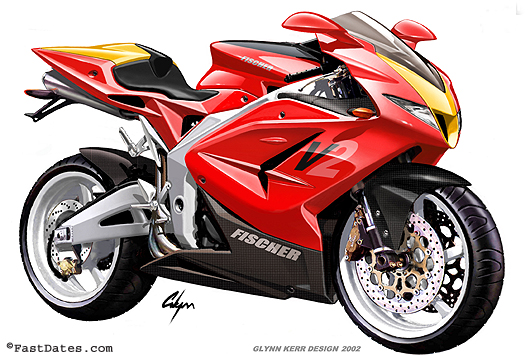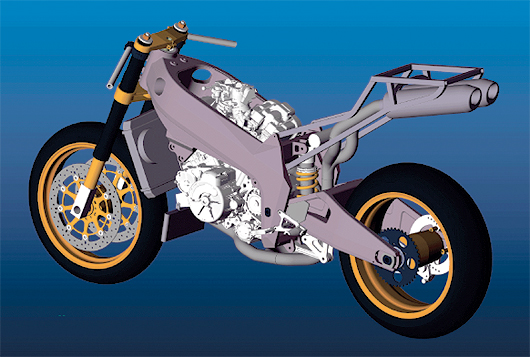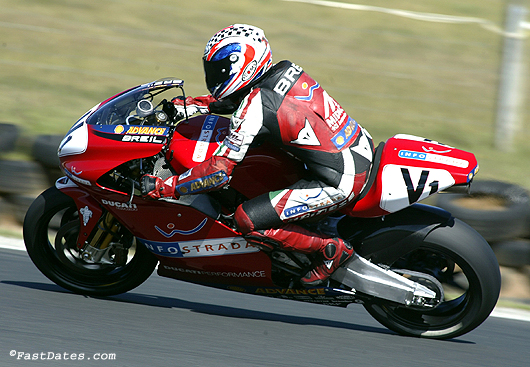|

Meet
America's newest Superbike - the Fischer
Dec.
17th: Fischer Motor Company, an Illinois Corporation,
has announced the development of the "first American Superbike
of the modern era." A collaboration among several top industry
veterans, the Fischer MR Series will be the first American motorcycle
to offer world-class performance and styling, and will accomplish
this by using the world's best suppliers. The vision of company
president and former racer Dan Fischer, the MR1000 is the first
product from the new company, scheduled to go into production-
in Chicago- late in 2004.
The chassis is being developed by Gemini Technology Systems of
Mukwonago, Wisconsin, previously known in the American motorcycle
market for unsuccessfully trying to develop the outdated Harley-Davidson
VR1000 Superbike into a competive race bike. Extensive research
was performed on many of the bikes currently offered by the various
manufacturers, and also the known numbers for some of the GP bikes.
"That's
where we based our geometry," says company president Dan
Fischer. "The MR chassis was done entirely in CAD before
any metal was cut. While the frame looks massive on the computer
screen, it's actually quite small like a GP chassis, but that
gives the flexibility to build bikes for a variety of purposes
and riders of any size. We also made sure that various engines
could be used, since building our own complete motor is still
some time away. With Gemini in charge of engineering, we'll definitely
have some performance engine parts that are ours on the first
product."
"The technology Gemini possesses is incredible," says
Fischer, "everything from CNC to FEA to
Computrack to carbon fiber."
Styling is
another area where Fischer has brought in world-class talent.
Famed Stylist Glynn Kerr penned the original drawings and collaborates
on design decisions directly at the Fischer R&D/engineering
facility. Kerr supervised clay modeling himself, and brings his
experience working with almost every major manufacturer to the
program.
The prototypes use the Rotax V-997 cc engine, the same one used
in the Aprilia Mille and their other big bikes. Rotax engineers
worked with Fischer and Gemini during development, but the Fischer
chassis was planned for use with multiple V-twins, in various
displacements. While the planning stage alone took almost a year,
the talent involved and the technology available, including rapid
prototyping machines, has moved the project along to where test
bikes are now being built.
Every motorcycle is the sum of its parts," continues Fischer,
"that's why we look at every single part for everything from
weight savings to styling. Having this much talent involved with
the project means that there isn't just attention to the details,
there's experience tending to the details, and that means everything."
As sportbike
fans we certainly welcome the Fischer's introduction to the American
market which has never been able to support a serious sportbike
manufacturer (with the possible exception of Buell). The obstacales
to success are endless. Their hand built, low volume bike will
never be able to compete on price with the Japanese manufacturers.
And the use of other manufacturers' V-Twin engines like the Rotax
employed in the Aprilia Mille R means the bike will have to perform
on par with the Mille R both in price and on the track to attract
buyers from that segment. A more up market, limited production
bike like a Bimota might be the way to go, but the design Fischer
shows below us is no more exotic than a current production Honda
SP-2 or Yamaha R1. The demand for, and profitable viability
of the Fischer sportbike still needs to be proven.
Look for more information soon, including testing videoclips at
www.Fischer1.com.


Barely
Legal!
Ducati says the 2003 999R model will come to America as a fully
street legal bike, unlike the previous 2 years' 996R and 998R
models which came without out street equipment because previous
Ducati North America management (now fired) was too lazy to get
them EPA and CARB approved. Surprised owners of those previous
"R" models who had advanced ordered them online at Ducatio.com,
had to shell out an additoinal $1,500 after delivery to buy the
missing steeet equipment the bikes had been advertised with.
The price
for the 999R will be $30,000 Euro (Racing Kit included). Local
luxury taxes excluded. Powered by a 999cc "Testastretta"
engine with 139 HP (bore 104 mm instead of 100mm used on the 996R,
999 and 999S), the bike is equipped with racing forged rims, radial
master cylinders and radial mounted calipers, upside-down fork
with radial caliper mounting, magnesium alloy head light support
and full carbon fiber fairing: the same components that make the
999R the king of the World Superbike Championship. Ducati.com
says they will close online ordering for the 800 bike production
run of 999R models on January 8th. Afterwhich, if any of the limited
production bikes remain unsold, they will be released after production
into the worldwide dealer network on a first come basis.

Above: Troy on the Multi Pulse Desmosedici at Phillip Island.
Ducati won't show us pictures of Capirossi or the new Marlboro
sponsorship bikes unitl January 1st when 2002 current sponsor
contracts expire.
Ducati
MotoGP Phillip Island 3-Day Tests
Ducato
Corse MotoGP Team at Phillip Island
Phillip Island, Australia, December 18-20th, 2002
Day 1: The Ducati Corse MotoGP squad has made
the long haul overseas to the spectacular Phillip Island circuit
not far from Melbourne in Australia for its latest round of testing,
the final session before the Christmas break. After the excellent
times recorded two weeks ago during Jerez testing, Loris Capirossi
and Troy Bayliss were both right on the pace with the new Ducati
Desmosedici in the first day of testing.
Conditions were excellent in the morning, but strong winds disturbed
the work of the squad in the afternoon. High temperatures (air
24°C / track 33°C) , similar to those encountered during
October’s Australian
GP, allowed the two Ducati Corse riders to complete the workload
for the Desmosedici, which revolved mainly around testing various
cooling components and all-new Michelin tyres for the 2003 MotoGP
championship.
Both riders tested on the 17” fronts used in MotoGP, and
Troy Bayliss, on his home track, was finally able to get to grips
with this particular tyre solution. During his 87 laps, he was
able to put home track knowledge to good use to set a quickest
time of 1’32.8.
48 laps today for Loris Capirossi, who despite harmlessly sliding
off at the Honda Curve with no damage to the bike, managed to
return to the pits and resume testing immediately. A series of
other minor problems prevented the Italian from stringing together
a lengthy series of laps, but despite this he set a time of 1’32.4,
which was close to the lap record set during the Australian GP.
The test
also highlighted the performance of Michelin’s 2003 tyres,
which remained at an excellent working temperature despite the
particular difficulty of the Phillip Island track, which presents
a long left-hand curve leading onto the pit-straight.
Day
2: The second day of testing for the Ducati MotoGP
team at the Phillip Island circuit in Australia saw Loris Capirossi
and Troy Bayliss continue development work on the new Ducati Desmosedici.
Phillip
Island is the first non-European track used for testing by Ducati
since development of the Desmosedici got underway. Testing conditions
remained good for the second day (air 25°C / track 40°C)
despite strong head winds along the main straight.
The Italian rider completed a total of 78 laps, using exclusively
race tyres. Loris tested a new fuel tank, which helped improve
the feeling with his braking and with the front, as well as continuing
tests on different rear suspension components. His best time was
1’32.3”.
Troy Bayliss also had a positive day’s testing on his home
track, completing 89 laps. The Australian tried out the different
fuel tanks and carried out a series of tests with different frames.
Bayliss also lapped on race tyres and his best time was 1’32.4”.
Both riders used the ‘Four Pulse’ engine and worked
on different configurations with different power delivery.
Day
3: Fog and damp conditions delayed the start of the final
day at Phillip Island for the Ducati Corse MotoGP team, but testing
continued in perfect conditions (air 21°C / track 27-38°C)
once the sun came out. Both Loris Capirossi and Troy Bayliss were
scheduled to complete a race simulation today as well as tests
with different chassis and rear suspension settings.
Loris completed a 27-lap long run without any problems and constantly
lapped in competitive times.
The Italian was pleased with the results of the race simulation
and the three-day test session and was satisfied with his choice
of a new chassis. Despite being at the start of his experience
with a four-stroke MotoGP bike, he now feels perfectly at home
with the new Desmosedici. Loris also focussed on tests with race
tyres, setting a quickest time of 1’32.1”.
Troy has come to terms with the increased power and lower weight
of the Desmosedici with respect to
the Ducati 998 Superbike he has raced for the past year. The Australian
rider encountered no problems during his race simulation, and
was also able to lap at a competitive pace. Troy’s schedule
today revolved around different rear suspension settings and testing
of new Michelin race tyres. His best time was 1’32.3”
“We can only be satisfied with the results of these tests
in Australia” declared Claudio Domenicali,
Ducati Corse Managing Director. “It has been a very demanding
year and I am happy that it has come
to an end with positive results, both for the brand-new Desmosedici
and the 999 Superbike, which lapped under the track record at
Valencia last week."
|
